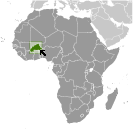World Atlas: Burkina Faso. On this page you can see the map, country flag and many detailed information about the people, history and economy of Burkina Faso.

Here you can find online selected information about the geography, inhabitants, government, economy and history of Burkina Faso. Included are selected statistics, an overview map and the detailed map of Burkina Faso. But let's start with the flag of Burkina Faso here:
Burkina Faso - Overview:
What you should know about Burkina Faso? Let's start with this: Burkina Faso (formerly Upper Volta) achieved independence from France in 1960. Repeated military coups during the 1970s and 1980s were followed by multiparty elections in the early 1990s. Former President Blaise Compaore (1987-2014) resigned in late October 2014 following popular protests against his efforts to amend the Constitution's two-term presidential limit. By mid-November, a framework for an interim government was adopted under the terms of the National Transition Charter. An interim administration, led by President Michel Kafando and Prime Minister Yacouba Isaac ZIDA, began organizing presidential and legislative elections planned for October 2015, but these were postponed during a weeklong failed coup in September. The rescheduled elections were held on 29 November, and Roch Marc Christian Kabore was elected president in the first round. Burkina Faso's high population growth and limited natural resources result in poor economic prospects for the majority of its citizens.
Geography of Burkina Faso
 Where on the globe is Burkina Faso? The location of this country is Western Africa, north of Ghana. Total area of Burkina Faso is 274,200 sq km, of which 273,800 sq km is land. So this is quite a large country. How could we describe the terrain of the country? This way: mostly flat to dissected, undulating plains; hills in west and southeast. The lowest point of Burkina Faso is Mouhoun (Black Volta) River 200 m, the highest point Tena Kourou 749 m. And the climate is tropical; warm, dry winters; hot, wet summers.
Where on the globe is Burkina Faso? The location of this country is Western Africa, north of Ghana. Total area of Burkina Faso is 274,200 sq km, of which 273,800 sq km is land. So this is quite a large country. How could we describe the terrain of the country? This way: mostly flat to dissected, undulating plains; hills in west and southeast. The lowest point of Burkina Faso is Mouhoun (Black Volta) River 200 m, the highest point Tena Kourou 749 m. And the climate is tropical; warm, dry winters; hot, wet summers.
Inhabitants of Burkina Faso
Let's take a look how many people live in Burkina Faso. The number is: 20,107,509. So quite a lot people live here. Who lives here? Mossi 52%, Fulani 8.4%, Gurma 7%, Bobo 4.9%, Gurunsi 4.6%, Senufo 4.5%, Bissa 3.7%, Lobi 2.4%, Dagara 2.4%, Tuareg/Bella 1.9%, Dioula 0.8%, unspecified/no answer 0.3%, other 7.2% (2010 est.). What are the languages in Burkina Faso? French (official), native African languages belonging to Sudanic family spoken by 90% of the population. And the religions: Muslim 61.5%, Roman Catholic 23.3%, traditional/animist 7.8%, Protestant 6.5%, other/no answer 0.2%, none 0.7% (2010 est.). How old are the people in average? 17.3 years. We have to add that this number is the median - so one half of the people is older than this, one half is younger. And what is their life expectancy (at birth)? This: 55.9 years. Where the people live in Burkina Faso? Here: the population is concentrated in the central and southern parts of the country; the east, north, and southwest are less populated. The major urban areas of Burkina Faso are: Ouagadougou (capital) 2.741 million (2015).
Government and Economy of Burkina Faso
The capital of Burkina Faso is Ouagadougou and the government type presidential republic. Let's take a look at the administrative divisions - 13 regions; Boucle du Mouhoun, Cascades, Centre, Centre-Est, Centre-Nord, Centre-Ouest, Centre-Sud, Est, Hauts-Bassins, Nord, Plateau-Central, Sahel, Sud-Ouest. Regarding the economy of Burkina Faso, important industrial products are cotton lint, beverages, agricultural processing, soap, cigarettes, textiles, gold. Important agricultural products are cotton, peanuts, shea nuts, sesame, sorghum, millet, corn, rice; livestock. The most important export commodities are gold, cotton, livestock and the most important export partners are Switzerland 65.7%, India 6.3%, South Africa 5.2%, Singapore 4.6% (2016). The most important import commodities are capital goods, foodstuffs, petroleum and the most important import partners are China 12.2%, Cote dIvoire 8.2%, Japan 7.8%, France 7.1%, Netherlands 4.5%, Spain 4.2%, India 4.1%, Russia 4% (2016). How rich is Burkina Faso and how rich are people in this country? The most important number here is GDP per capita (PPP): $1,900 (2017 est.). This is a very low number. Let's add that this means Gross Domestic Product per person, which is recalculated with respect to the relative cost of local goods and services. And one more important number - population below poverty line: 40.1% (2009 est.).